The Nexus 7 (2013) Review
by Anand Lal Shimpi on August 22, 2013 6:00 PM EST
Truth be told, Google has made (or at least directed the making of) some of the best tablets on the market today. The original Nexus 7 was groundbreaking in that it offered a totally usable platform, married to the latest version of Android, for $199. The Nexus 10 gave us a very quick, ultra high resolution 10-inch tablet for $100 less than the flagship iPad (and with more storage). Both were easily recommendable due to their value, but this year Google is stepping out of the shadow of value and into one of excellence. It starts with the new Nexus 7.
Based on the success of the original Nexus 7, Google went back to ASUS for the second version. In the 12 months since the release of the Nexus 7, the world has changed quite a bit. Expectations for value tablets had been reset by the original Nexus 7 as well as Amazon's lineup of Kindle Fires. Simply showing up with another good value likely wouldn't do anything to further the brand (or market). I get the distinct impression that Google isn't big on not changing the world.
| Nexus 7 Tablet Specification Comparison | ||||
| ASUS Nexus 7 (2012) | ASUS Nexus 7 (2013) | |||
| Dimensions | 198.5 x 120 x 10.45mm | 200 x 114 x 8.65mm | ||
| Chassis | Plastic + Rubber back | Plastic + Soft Touch back | ||
| Display | 7-inch 1280x800 IPS | 7.02-inch 1920x1200 IPS | ||
| Weight | 340 g | 290 grams (WiFi), 299 grams (LTE) | ||
| Processor | 1.3 GHz NVIDIA Tegra 3 (T30L - 4 x Cortex A9) | 1.5 GHz Qualcomm Snapdragon S4 Pro (APQ8064-1AA) | ||
| Memory | 1 GB | 2 GB DDR3L | ||
| Storage | 8 GB / 16 GB | 16 GB / 32 GB | ||
| Battery | 16 Whr | 15.01 Whr | ||
| WiFi/Connectivity | 802.11b/g/n, BT, NFC | 802.11a/b/g/n, BT 4.0, NFC | ||
| Camera | 1.2MP Front Facing |
5.0 MP Rear Facing w/AF 1.2MP Front Facing |
||
| Wireless Charging | – | Yes (Qi Compatible) | ||
| Pricing | $199/$249 |
$229/$269 (WiFi 16/32 GB) $349 (LTE) |
||
The result is the new Nexus 7. Identical only in name, manufacturer and screen size, the 2013 Nexus 7 is a downright Apple way to rev a product. Google made it thinner, lighter, faster and better in almost every way.

2013 Nexus 7 (left) vs. 2012 Nexus 7 (right)
The original Nexus 7 was rather thick but it got away with it since the overall footprint of the tablet was so small. The new Nexus 7 truly feels like a slate. It's the type of thing I expect to see carried around on the Enterprise.
I don't miss the rubber imitation leather from the original Nexus 7, it's replaced by a soft touch plastic back. You definitely don't get the premium aluminum feel of the iPad mini, but the device doesn't feel cheap either. The new Nexus 7 is still nice enough that I'm nervous about scratching or scuffing the back.
Both ASUS and Nexus logos are prominently featured on the back. ASUS continues to amaze me by just how far it's come as a company, and the new Nexus 7 is hands down its most impressive tablet creation yet. From a build quality standpoint I really have no complaints about the Nexus 7. While the MeMO Pad HD7 has some creaks and flex in the chassis, the new Nexus 7 feels like a solid slab of soft plastic and glass. It's nice.
Unlike the original Nexus 7, the new model features stereo speakers on back of the tablet. It's an easy feature to take for granted but going back to the old mono design sounds worse.
I agree with Brian that the power/lock and volume buttons are the only real sore spot on the physical execution. They aren't particularly well defined and feel a bit mushy. Even writing this paragraph feels like I'm nit picking though, the build here is really good.
The only other complaint I'd levy against the new Nexus 7 is that the design doesn't particularly stand out as being unique. The iPad has its aluminum, the Moto X has its wood, but the Nexus 7 falls victim to the fact that ultimately it's tough to make these ultra mobile devices stand out. You need a large glass surface and you need a back. Black also tends to be one of the easier colors to sell (get too creative and you end up with inventory problems). It's not a huge deal to me personally, but as mobile devices can often be fashion statements I don't know that the new Nexus 7 has all that much curb appeal.
The Display
What the Nexus 7 lacks in pizazz, it completely makes up for once you power on the display. The 7-inch 1920 x 1200 display produces colors that are not only vibrant but, for the first time ever in a Nexus device, accurate as well. Google really worked on color accuracy this time, with a two step calibration process - once at a high level by the panel maker and once again per device during final manufacturing. The result is just awesome:
The Nexus 7 display is not only visually appealing but stacks up incredibly well in our CalMAN display tests. Although it loses to the iPad 4, the Nexus 7 gets indiscernibly close in many cases and blows the non-Retina iPad mini out of the water. I won't even bother comparing it to everything else in the Android space, they don't hold a candle to it.
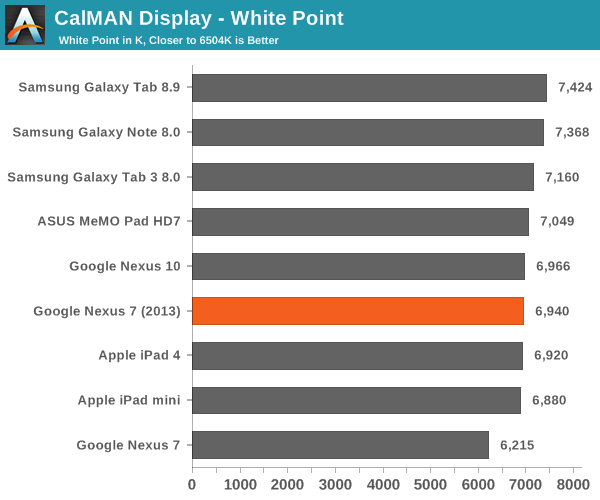
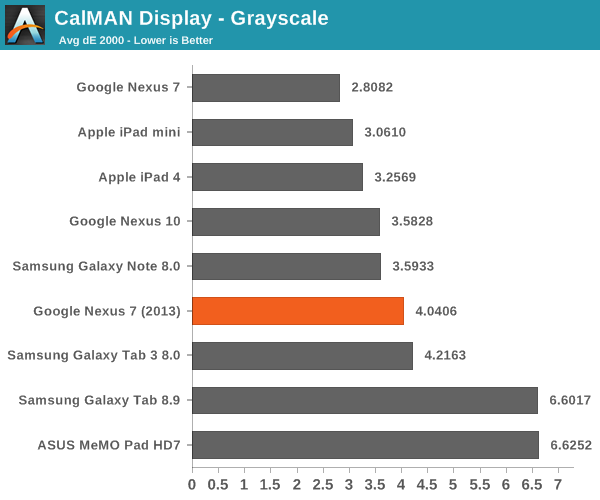
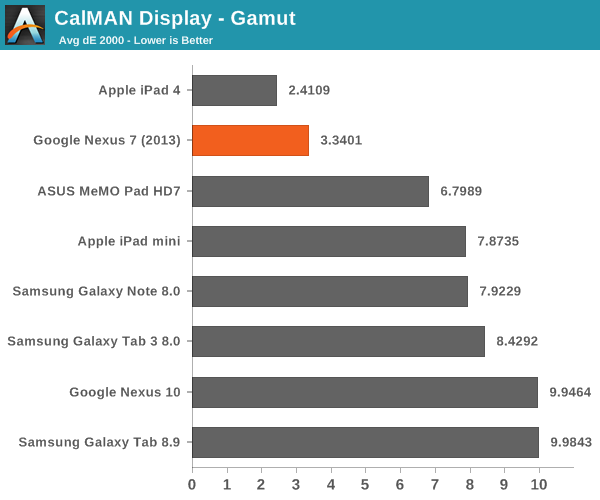
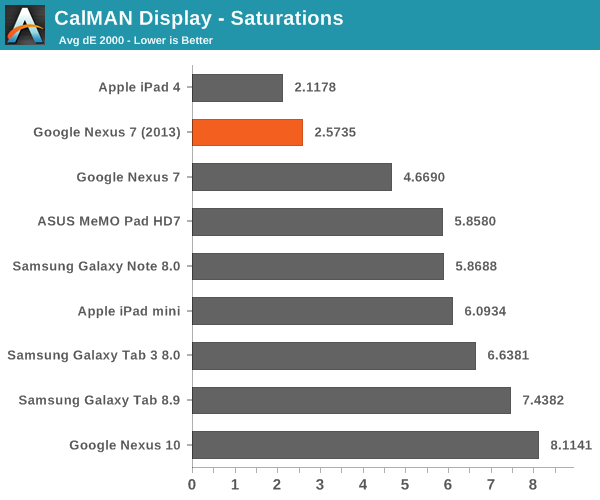
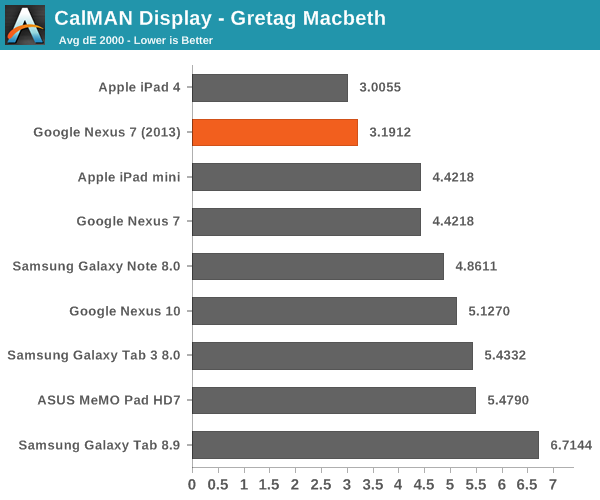
The new panel is also incredibly bright. I typically view 500 nits as the threshold for outdoor usability, and the new Nexus 7 definitely exceeds that threshold. The tablet will drink away all of your battery life if you leave it at this brightness setting indefinitely, but if you need to actually use your tablet outdoors for a while the Nexus 7 works.

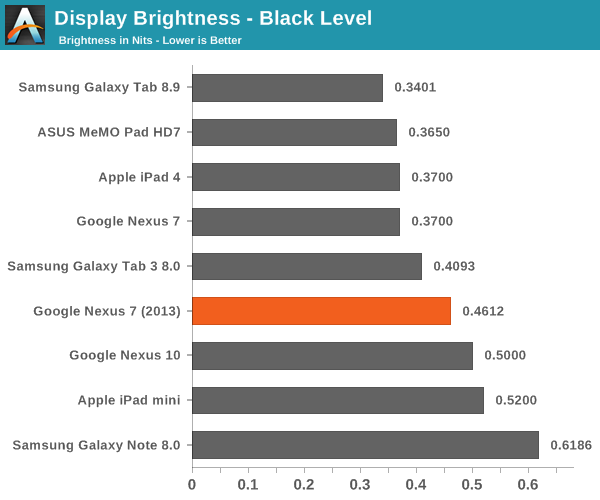
Black levels are a bit higher than on the original Nexus 7, but the resulting peak contrast ratio is still excellent:
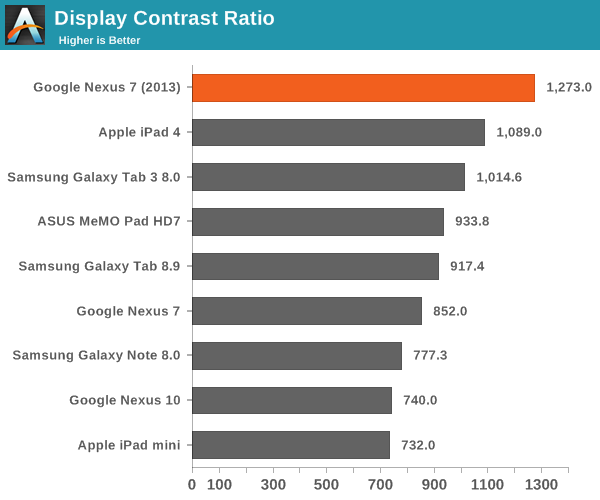
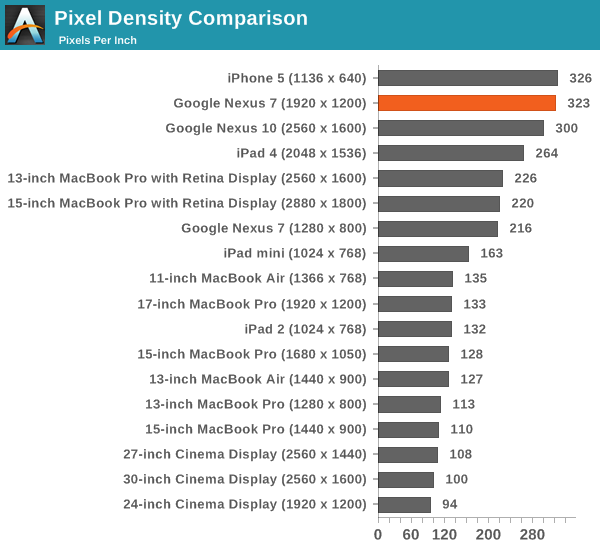
Pixel density shoots through the roof with the new Nexus 7 display as well. Brian was quick to point out that a major advantage of the Android platform is in its flexible resolution handling. The 1920 x 1200 panel presents itself as a 960 x 600 panel to web pages in Chrome, while other apps can use every last pixel for unique content (e.g. games).
The beauty of not having to double the original Nexus 7's resolution but instead settling on an in-between option like 1920 x 1200 is that Google could get away with a performance mainstream SoC instead of something ridiculously high-end.
The display looks great when viewing everything from photos and movies to web pages and eBooks. My only complaint about the Nexus 7's display is its size. A 7-inch tablet is almost pocketable (in fact I did carry it around in my pocket for a day), but the screen can feel a little cramped.


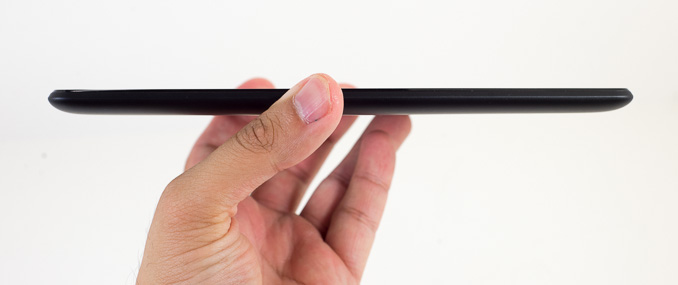
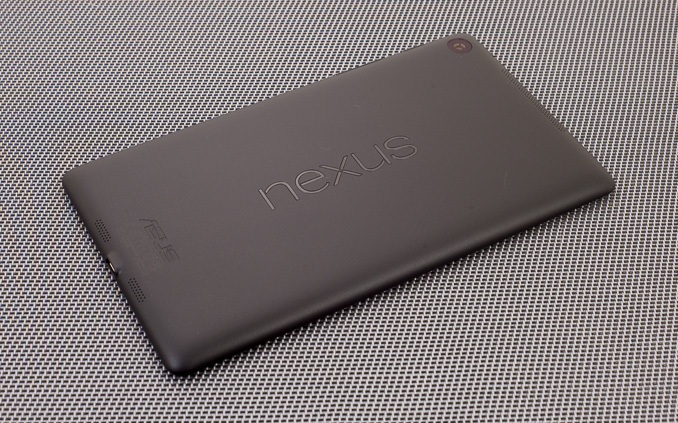
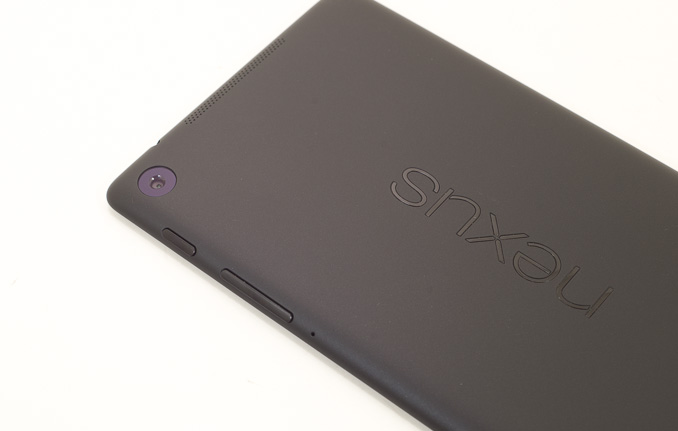


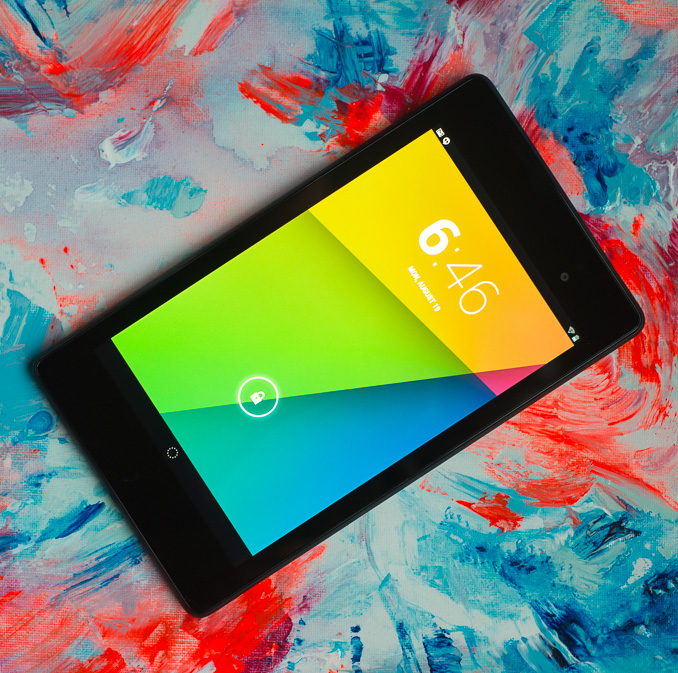
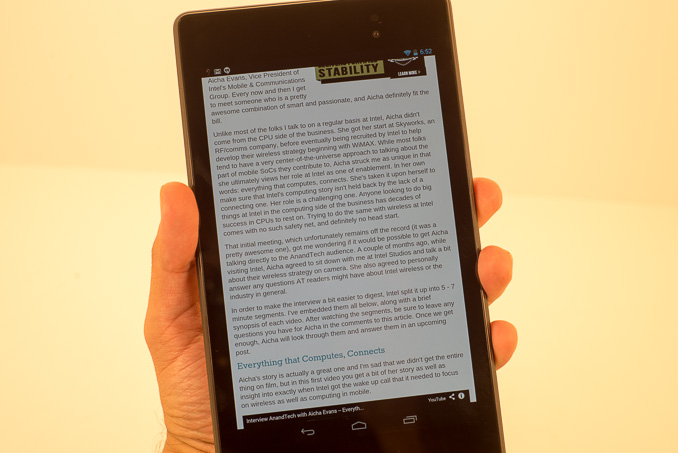
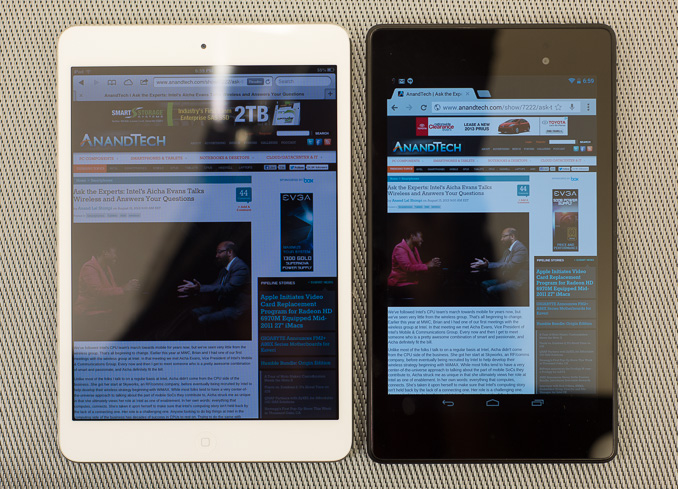








202 Comments
View All Comments
doobydoo - Sunday, August 25, 2013 - link
Retina is an Apple marketing term but the science behind it is not Apple's to change.Put simply, a retina device is a device which, when used at a normal viewing distance (11 inches for smartphones, for example) does not have discernible pixels for people with 20/20 vision.
That's the definition, period.
Whether it's useful to you or not depends on whether you have 20/20 vision, or perhaps whether you hold your device closer or not.
The iPad 4 is retina because it would typically be held further away from your eyes than a smartphone, whereas the Nexus 7 with its significantly smaller screen would be held closer (but also still qualifies as retina).
For perfect vision, the absolute best you can find in anyone, ever, at 12 inches you'd be looking at a possible perception of 700 PPI.
Fri13 - Thursday, November 14, 2013 - link
Now after a longer time when both has been released, a Nexus 7 (the 2013 model) and iPad Mini (with Retina display) there is no actual difference.Nexus 7 has 323 PPI while iPad Mini has 326 PPI so the difference is only a 3 pixels what is nothing even if other would have only 150 PPI. As that is small enough to offer a sharp text and pictures and in this case both are over 320 PPI what is over twice needed to offer sharp text and pictures. The first gen iPad mini was 163 PPI what was enough, but for many it isn't "enough" because they want specs to be updated no matter if there are no reasons to do so.
And you don't want to compare operating systems, it is useless as you don't want to compare filesystems, process schedulers, filesystem schedulers, memory management efficiency, network protocols stacks like TCP/IP or process threading etc etc. You want to compare only the graphical user interfaces like what user see, how they are designed (logic) and what functions does device offer for developers so users can post-install wanted software from different sources than just manufacturer own (so you can be in control of your device) and most important thing, how well does the devices work in ecosystem (== how well can all devices share data between each other no matter who is manufacturer or what software is used. Every device belongs to one and the same "ecosystem").
darwinosx - Thursday, August 22, 2013 - link
Android tablet apps are not close to iOS tablet apps in selection and quality. Anyone who owns a Nexus 10 knows this if they are truthful.There will be a new iPad Mini in a few weeks and Apple will settle all family business. The old iPad Mini sold dramatically better than the old Nexus 7 and this will be no different.
What you and Anand don't mention is that Nexus devices are sold at cost.
As I said earlier I have bought three of these as gifts in the last month or so. But the screen is too small for me and app quality and election is lacking. A retina iPad Mini is going to blow the doors off the Nexus 7 in sales. Watch.
smartypnt4 - Thursday, August 22, 2013 - link
Well, no one ever argued that...The iPad mini will sell more, regardless of how the specs compare. That's simply because there's a lot of people in this world that want something they already know how to use, and iOS is what the learned at the beginning of the smartphone race.
Now, that app selection thing: the advantage of the 7" form factor is that the apps built for phones aren't completely useless on this screen. After owning a N10 and now a 2013 N7 (with an iPad in between, mind you), I can say that the situation on the N10 was terrible. So many apps just didn't come close to being usable. The other bit is, I really don't use that many apps any more, so there may be some people in that camp. I can't say for sure due to my relatively small sample size (me and a few friends who care).
All in all, Apple has no excuse if they don't show up with a retina-fied iPad mini this fall. Last year, it was argued that the mini doesn't have an awesome screen due to cost, availability, and the power drain it'd suffer. The 2013 N7 shows that it's completely possible to do in today's world, regardless of what was possible last year. I really do hope Apple shows up with a good competitor specs-wise, because I'd hate to not have a choice as far as small tablets are concerned. We hardly have a choice on the large tablet side as it is.
mmarafie - Friday, August 23, 2013 - link
AgreedWarpGuN - Friday, August 23, 2013 - link
crap apple will never compete spec-wise with Nexus they will always be behind. Overpriced crap designed for the non-geek, Android is dominating with smartphones and tablets Apple is losing market shares everydayakdj - Friday, August 23, 2013 - link
WarpGun....what? Are you six years old? That's your offering to the discussion? Good grief....grow up a bit, then come back and join us for a real discussion. The two companies go back and forth every year beating each other in 'specs'. Just take a look at last years gear vs this years. Ridiculous comment, as the iPad (both mini and regular) are at the end of their cycle. And with this in mind, the iPad 4 still fairs pretty well against current competition even being a year old.The article hasn't anything to do with market share...but Apple has never 'lost' market share. Each iteration if iOS device has outsold the last. In fact, this past quarter the iPhone outsold YoY itself by an extra 5mil units. Get out of your basement, get a job, and try to contribute to the discussion at hand rather than spread your personal agenda
The new nexus 7 is one helluva tablet. An excellent review from a legitimate reviewer to boot. Isn't that enough to make you 'happy' to be an Android fan?
Miggleness - Friday, August 23, 2013 - link
This is the first time I paid attention to the size difference between the Nexus and iPad Mini. That's another big factor in my next purchase and the Nexus just feels too small.Thanks for the review Anand. This is the reason I keep coming back to your site.... twice daily!
ESC2000 - Sunday, August 25, 2013 - link
Actually the nexus displays more on its screen than the mini because of how many more pixels the nexus has even though the mini's screen real estate is about a third bigger. I've messed with the two next to each other and the nexus looks way better. Of course the nexus is much newer. Still I expect the new mini to be either overpriced or underspecced... or both like the first mini.doobydoo - Monday, August 26, 2013 - link
Actually, no it doesn't, because despite the increase in resolution, the Nexus doesn't shrink everything compared to its predecessor. It still displays less than the iPad Mini, because if it didn't everything would be too small.I also now don't believe that you've compared the two side by side because if you had, you would know this.